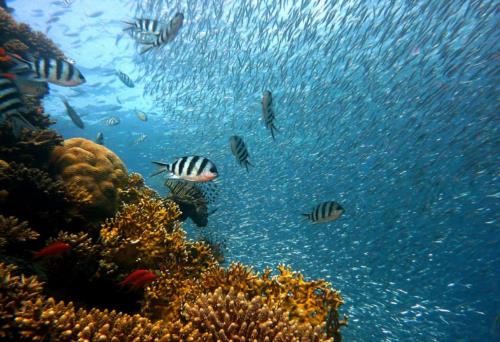 One of the greatest attractions of Raja Ampat, if not the greatest, is sinking into the crystal-clear waters, to discover an ocean floor with the greatest biodiversity on the planet.
One of the greatest attractions of Raja Ampat, if not the greatest, is sinking into the crystal-clear waters, to discover an ocean floor with the greatest biodiversity on the planet. It’s no exageration to say that it is home to 75% of all existing coral species, as well as to around 700 species of mollusks and 1427 species of fish. A true paradise for divers who seek new adventures and unique places to explore!
The first thing you should know about Raja Ampat is that
each of its remote islands allows you to disconnect from routine, while connecting intimately with nature, just what diving aficionados long for! If this is the first time you hear about Raja (I hope not!), please, do not hesitate in reading this article about everything in
Raja Ampat.
Also,
in every corner you will find striking landscapes and colorful new species that will be engraved in your memory for a long time. One of the advantages of this archipelago is that any diving spot you choose takes you on a new adventure of exploration and discovery!
How could you possibly get bored, either in or out of the water, in Raja Ampat, when you have such extraordinary dive spots to choose from? No way!
The manta rays are one of the main attractions for divers, since this species of elasmobranchii has declined in other parts of the world, due to harpoon hunting. But in Raja Ampat, and especially in Manta Sandy, it’s very common to see them swimming along tranquilly in their natural habitat. In this remote area of the Coral Triangle, nature has been maintained in its purest state, and both locals and visitors work together to conserve it.
Another favorite dive spot in Raja Ampat is Batu Lima, which in Indonesian means ‘Five Rocks,’ in reference to the islands forming a unique underwater ecosystem. This area is well known for its reef filled with corals, batfish and fusiliers, and for being a good place to watch whitetip blackspot sharks from close up.
Sardinas Reef is the best spot for seeing and photographing the Wobbegong shark, known for its ability to camouflage itself and for being difficult to find outside of Australia. This oval-shaped reef is full of corals and schools of fish that attract predators like the Wobbegong and the Barracuda.
If, after an amazing dive, you don’t feel like going back to your room right away, there are many choice spots for snorkeling and watching a wide variety of marine fauna, like Mioskun or Chicken Reef, one of the most visited points in the archipelago.
For more information,
read this article about main dive sites in Raja Ampat.Safety and Diving Equipment in Raja Ampat
Raja Ampat’s remote location and difficult access make it a perfect place to disconnect and relax. At the same time, it means that you need to take certain precautions. These include buying medical insurance, bringing along replacement parts for your diving equipment, and exchanging money before you arrive.
If you dive, you know how important it is to control the pressure during descent and ascent, in order to avoid health risks. Some resorts specializing in diving have emergency oxygen. But if you aren’t careful in your dives, the nearest hyperbaric chamber for treating decompression sickness is in Manado, which involves an emergency airlift. Please remember to come here with a valid medical insurance policy that would cover such expenses, and you’ll be able to relax and enjoy the marvels of diving in Raja Ampat.
On the archipelago of Raja Ampat, as in the rest of Indonesia, it isn’t easy to find replacement parts for diving equipment. In order to secure them, you would need to travel by boat or plane. Because of this, and for your safety, if you come to dive in Raja Ampat, please be sure that your equipment is in perfect working condition and remember to bring along replacement parts with you.
The warm, crystal-clear waters of Raja Ampat are a delight for diving aficionados, both beginners and experts, at any time of year. The archipelago has a tropical climate that keeps the water temperature at approximately 26ºC all year round. Also, its moderate currents let you enjoy excellent visibility underwater.
The pure blue of the deepest dives in Raja Ampat is perfect for capturing images of morays, vividly colored soft corals, and hundreds of other marine species. And did you know that some of the best known dive spots in the archipelago were discovered by divers visiting the area (like Francisco’s Peak or Mike’s Point)? As you can see, there’s a lot left to explore in Raja Ampat!
Hope you love this paradise as I love :)